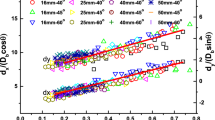Abstract
The time and depth of vertical one-dimensional projectile penetration into sandy media in the near shore region are derived. A precise definition for the physical properties and for the behavior of the sandy medium following the projectile impact are evaluated. Three separate time intervals following projectile impact are identified. During the first 3 ms of penetration, the deviatoric friction stress is shown to be negligible and the integrated Mie–Grüneisen equation of state (or, equivalently, the Hugoniot-adiabat) may be applied to compute the normal penetration resistance force from the sand pressure. In order to compute sand pressure as a function of the sand density D by the integrated Mie–Grüneisen equation of state, the Mie–Grüneisen dimensionless constants γ0 and s and the dimensional speed of sound C 0 in the sandy medium are required. In order to illustrate the one-dimensional shock wave propagation in both wet and dry sands, Hugoniot data for wet and dry silica sands are evaluated by a three degrees of freedom algorithm to compute these required constants. The numerical results demonstrate that the amplitude of the shock wave pressure in the wet silica sand (41% porosity) is approximately one-third of the shock wave pressure amplitudes in the dry silica sands (22% and 41% porosity). In addition, the shock wave pressure dampens quicker in the wet sand than in the dry sands.





Similar content being viewed by others
References
Allen WA, Mayfield EB, Morrison HL (1957a) Dynamics of a Projectile Penetrating Sand. J Appl Physi 283:370–376
Allen WA, Mayfield EB, Morrison HL (1957b) Dynamics of a Projectile Penetrating Sand. Part II. J Appl Physi 2811:1331–1335
Bass RC, Hawk HL, Chabai AJ (1963) Hugoniot data for some geological materials. Sandia Laboratory, Albuquerque, N.M., p 18
Goldsmith W (2001) Impact: the theory and physical behavior of colliding solids. Dover Pub. Inc., Mineola, New York
Guenther RB, Gyde N, Hudspeth RT, Harvey WB (2004) “Comparisons of Two Target Media Resistance Formulae to High Speed Penetrators”, ONR Annual Report, 17p
Papanastasiou TC, Boudouvis AG (1997) Flows of viscoplastic materials: models and computations. Comput & Struct 641-4:677–694
Press WH, Flannery BP, Teukolsy SA, Vetterling WT (1987) Numerical Recipes. Cambridge Univ. Press, New York
Acknowledgments
Financial support was provided to RBG and RTH by the Office of Naval Research (ONR), Ocean Engineering & Marine Systems under Grant NO. N00014-02-1-0116. Financial support to AK was provided by King Fahd University of Petroleum and Minerals, Dhahran, Saudi Arabia. We have benefitted from stimulating and productive discussions with W. B. Harvey who identified the importance of the different initial time intervals in determining when the contribution of the deviatoric stress should be included in the sand resistance force algorithm.
Author information
Authors and Affiliations
Corresponding author
Appendix
Appendix
Generic Resistance Formulae
The two target medium resistance force formula with three degrees-of-freedom (DOF) are (1) a quadratic and (2) an elastic. Either of these formulae may be applied in different forms that depend on the number of DOF that are selected. Each formula may be evaluated for conical, ogival or spherical nose shapes [5].
Allen et al. [1, 2], inter alia, posited the following generic quadratic target resistance formula where the subscript Q denotes quadratic medium resistance formula:
The gravitational body force is included in the constant term b for vertical projectile penetrations [vide Fig. 1]. An elastic medium resistance formula may be written as
where the subscript E denotes elastic medium resistance formula.
Figure A1 compares the quadratic medium resistance formula with three DOF with penetration data from aluminum targets. Figure A2 compares the elastic medium resistance formula with three DOF with penetration data from aluminum targets.
Comparison between quadratic medium resistance formula equation (A1a) for a spherical nose projectile with three DOF and penetrations into aluminum target medium
Comparison between elastic medium resistance formula equation (A1b) for a conical nose projectile with three DOF and penetrations into aluminum target medium
Rights and permissions
About this article
Cite this article
Kharab, A., Hudspeth, R.T. & Guenther, R.B. Penetration of Cylindrical Projectiles into Saturated Sandy Media. Exp Mech 49, 605–612 (2009). https://doi.org/10.1007/s11340-008-9190-9
Received:
Accepted:
Published:
Issue Date:
DOI: https://doi.org/10.1007/s11340-008-9190-9






